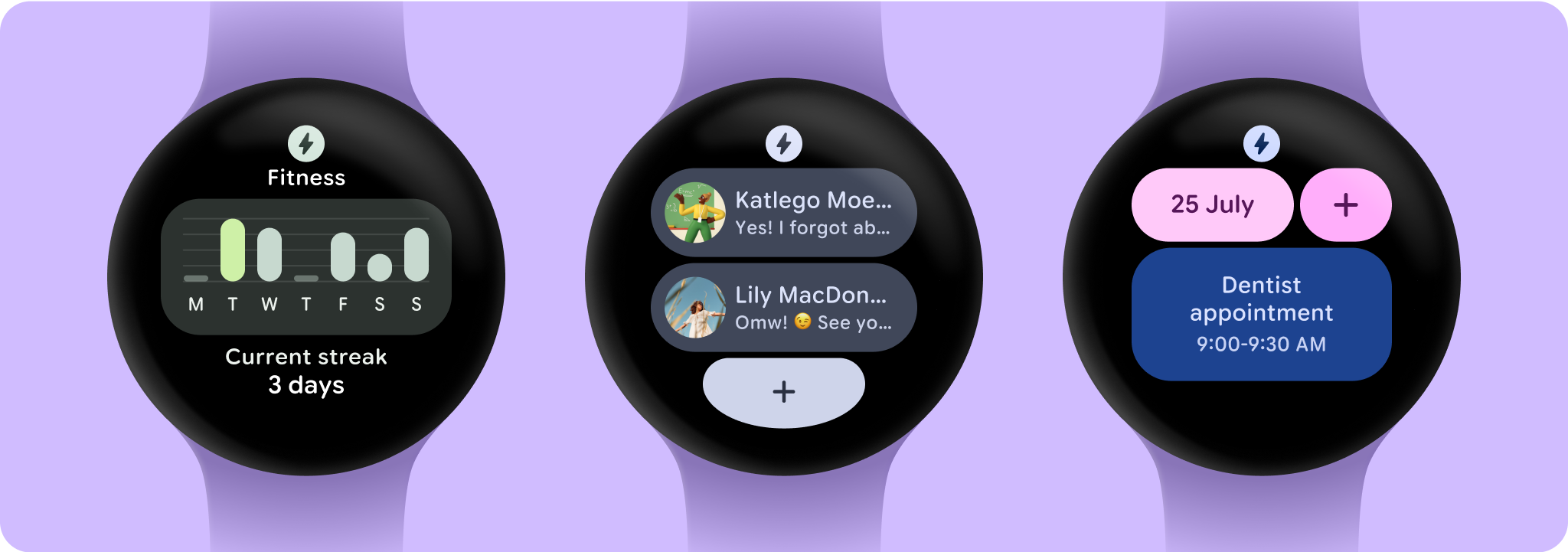카드를 통해 사용자는 작업을 완료하는 데 필요한 정보와 작업에 쉽게 액세스할 수 있습니다. 시계 화면을 스와이프하면 카드 캐러셀이 표시되고 추가 스와이프하면 카드 간에 전환됩니다. 타일 자체는 스크롤할 수 없습니다.
사용자는 보고 싶은 카드를 선택할 수 있습니다. 제공되는 카드로는 날씨 확인, 타이머 설정, 일일 피트니스 진행 상황 추적, 빠른 운동 시작, 노래 재생, 예정된 회의 검색, 즐겨찾는 연락처로 메시지 전송이 있습니다.

카드는 Compose (또는 뷰)를 사용하는 대신 Jetpack의 protolayout 및 tiles 라이브러리를 사용하여 선언적으로 정의됩니다. 카드는 별도의 원격 환경에서 렌더링되므로 카드 내에서 데이터를 로드, 표시, 업데이트하는 데는 다른 접근 방식이 필요합니다. 간단하기 때문에 빌드, 테스트, 배포가 쉽습니다.
핵심 원칙
Wear OS는 사용자가 카드를 슬쩍 보고 확인할 수 있는 적은 양의 주요 정보를 표시하는 한 가지 수단으로 카드를 제공합니다. 사용자에게 고품질 환경을 제공하려면 다음 권장사항을 따르세요.
- 카드를 너무 많은 콘텐츠로 채우지 않습니다. 대신 사용자가 카드를 탭하여 자세히 알아보고 앱의 다른 표시 경로에서 조치를 취할 수 있도록 구현합니다. 컨테이너를 하나 이상 포함을 참고하세요.
- 카드의 레이아웃과 콘텐츠를 선언적으로 정의합니다. 시스템에서 최종 렌더링을 담당합니다.
- 카드 서비스에서 콘텐츠를 너무 자주 가져오거나 오래 실행되는 비동기 작업을 시작하지 않습니다. 완료하는 데 시간이 걸릴 수 있는 작업(예: 네트워크 호출)을 실행하려면 WorkManager를 사용하여 백그라운드 작업을 예약하고 결과를 로컬 저장소에 캐시하거나 저장합니다.
추천 서비스
- 참고: JavaScript가 사용 중지되어 있으면 링크 텍스트가 표시됩니다.
- 카드에 동적 업데이트 표시
- ProtoLayout 네임스페이스로 이전

